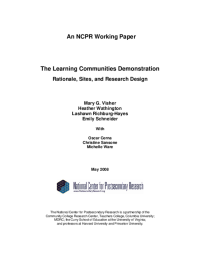The Learning Communities Demonstration
Rationale, Sites, and Research Design
With their open admissions, low cost, and convenient locations, community colleges have taken great strides in recent decades in providing access to college for millions of students with diverse ethnic and academic backgrounds. Now, however, community colleges must tackle an even more formidable challenge: how to help increasingly large numbers of academically underprepared students succeed in college. The developmental courses to which over half of entering students are directed often prove to be too great a hurdle, and the majority who hope to earn a certificate or a degree, or to transfer, drop out before reaching their goals.
Learning communities are a popular strategy that community colleges nationwide have embraced in support of developmental students. In a learning community, a cohort of students takes two or more courses linked by integrated themes and assignments that are developed through ongoing faculty collaboration. Learning communities are intended to foster active and collaborative learning and to create stronger relationships among students and between students and faculty. These elements are theorized to increase students’ motivation and sense of belonging, which in turn drive their effort, learning, persistence, and, ultimately, success.
While the number of learning community programs continues to grow, rigorous studies measuring their effectiveness are limited. To address this need for evidence, the Learning Communities demonstration, launched in 2007, uses random assignment to test models of learning communities at six community colleges: Kingsborough Community College, Queensborough Community College, Hillsborough Community College, Merced College, Houston Community College System, and Community College of Baltimore County. Five models serve developmental students in their first semester, and the sixth model enrolls second-semester students. The study is designed to answer three sets of questions:
- How can learning communities be designed to address the needs of academically underprepared students?
- What are the effects of learning communities on student achievement, as measured by test scores, credits earned, and grades? What are the effects of learning communities on students’ persistence in higher education?
- What do learning communities cost and how do these costs compare with the costs of standard college programs for students with low basic skills?
Preliminary findings will be available in 2009. This working paper describes the study’s design, including a summary of the theoretical and empirical research relevant to learning communities, descriptions of the sites and their learning community models, the random assignment procedures, and plans for data analysis.






